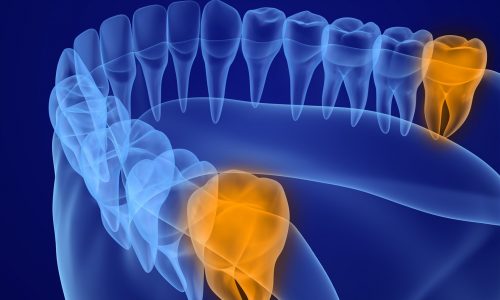Wisdom Teeth Extractions in Langford
Experiencing Pain or Crowding Issues?
Wisdom teeth, often referred to as third molars, are the last adult teeth to erupt in the mouth, typically around the late teens or early twenties. It is most common to have four wisdom teeth in total, two upper and two on the lower mandible. It is possible, however, to have fewer or more of these teeth which can be identified with digital X-rays of the jaw.
Wisdom teeth tend to have long root systems that continue to grow as patients age. Long root systems can lead to a root that joins with the upper sinus cavity, or, roots that impact the alveolar nerve of the mandible. With increased risk of damage to other teeth and bone, as well as the possibility of developing cysts at the root ends, many dentists now opt for removal of the wisdom teeth to mitigate these risks. Additionally, wisdom teeth are so far back in the mouth that even if they erupt properly, they often fall victim to decay or gingivitis because it is difficult to access these teeth at the back of the mouth for proper and thorough cleaning.

Wisdom Teeth Extractions in Langford
Experiencing Pain or Crowding Issues?
Wisdom teeth, often referred to as third molars, are the last adult teeth to erupt in the mouth, typically around the late teens or early twenties. It is most common to have four wisdom teeth in total, two upper and two on the lower mandible. It is possible, however, to have fewer or more of these teeth which can be identified with digital X-rays of the jaw.
Wisdom teeth tend to have long root systems that continue to grow as patients age. Long root systems can lead to a root that joins with the upper sinus cavity, or, roots that impact the alveolar nerve of the mandible. With increased risk of damage to other teeth and bone, as well as the possibility of developing cysts at the root ends, many dentists now opt for removal of the wisdom teeth to mitigate these risks. Additionally, wisdom teeth are so far back in the mouth that even if they erupt properly, they often fall victim to decay or gingivitis because it is difficult to access these teeth at the back of the mouth for proper and thorough cleaning.

How Do We Decide?
The dentist’s management of third molars is generally subject to identifying the presence of symptoms or disease that clearly is attributable to the third molars. A panoramic x-ray is required for the dentist to assess the wisdom teeth. A panoramic x-ray is a two-dimensional dental x-ray that captures the entire mouth in a single image, including the teeth, upper and lower jaws, and surrounding structures and tissues. The dentist will review symptoms in addition to clinical and radiographic evidence in determining if removal of one tooth or all wisdom teeth is the best course of action.
Common Complications
Wisdom teeth are large, and therefore have large space requirements along the jaw line. Sometimes when they emerge, wisdom teeth put stress on the surrounding teeth as they try to make room for themselves. Although new research suggests that wisdom teeth are not likely to cause other teeth to become crooked, they can get stuck as they try to emerge which can lead to impaction.
Wisdom teeth that are impacted do not necessarily require removal. We can identify if and what kind of impaction each of your teeth is experiencing in order to determine whether or not removal is the best course of action.
Wisdom teeth that are fully impacted in the jaw bone are referred to as complete bony impactions. In this case, the tooth does not rise out of the jawbone and remains trapped in the bone tissue. Although some fully impacted teeth can remain this way without concern, your dentist will want to ensure that there are no cysts developing on the roots of the teeth, as these can cause degeneration of the bone which can be more difficult to manage.
Soft tissue impaction refers to wisdom teeth that have started to rise beyond the jaw bone but stop short of emerging from the gum tissue. The proximity of the tooth to other root systems within the gingival tissue can result in inflammation or infection.
How Do We Remove Wisdom Teeth?
The extraction process involves numbing the area using local anesthesia and making an incision into the gum tissue or bone in order to expose the tooth. This can involve removing a portion of the bone to release the tooth. During your assessment with the dentist prior to the day of surgery, details of your extraction process can be thoroughly explained so a good understanding of the procedure is clear prior to extraction. Following the extraction, your dentist may use stiches to assist in the healing process, these usually dissolve on their own after a few days.
How We Support Our Patients
Wisdom tooth removal is a common practice, but we understand that extractions of any kind can induce anxiety in our patients. Our priority is that you feel welcomed and supported before the procedure begins, so that you can relax and know what to expect. We ensure that we have good communication with you, including agreed-upon hand signals to ensure that you can communicate with us during the procedure as needed.
Patients whose anxiety is not addressed by communication and reassurance alone, may be interested in availing of the oral sedation or nitrous oxide (laughing gas) offerings at our clinic. Oral sedatives can calm an overactive nervous system, and gas is a safe and effective way for you to retain a sense of calm relaxation during your procedure.
Parkway Dental Services
Parkway Dental Clinic offers a full range of dental services in Langford. From Checkups & Cleanings to Invisalign to Cosmetic Dentistry!
Time To See A Dentist?
Schedule An Appointment
Book your dentist appointment online. Select the next convenient time or book ahead to your preferred date. We look forward to seeing you!
We Will See You Soon!
Our Contact Info
961 Langford Parkway
Langford, BC V9B 0A5
1-778-433-7732
When to visit us?
Clinic Hours
Closed: Weekends & Holidays




